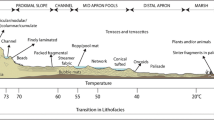Abstract
The 3,500–3,400 Myr Onverwacht Group in the southern part of the Barberton Greenstone Belt, South Africa, includes up to 12 km of komatiitic and tholeiitic lavas containing minor sedimentary and felsic volcanic units1. Komatiitic lavas showing spinifex textures, chrome spinels and high Ni and Cr contents are common throughout the sequence2. The rocks have been subject to polyphase Archaean deformation and low-grade metasomatism2–4. At several positions within the Onverwacht Group (Fig. 1), the tops of komatiitic lavas underlying chert beds are marked regionally by 1–50-m thick zones of silicification, carbonatization and K2O enrichment (Fig. 2). Because these zones have been variously interpreted to represent the felsic tops of mafic-to-felsic volcanic cycles, weathering horizons and shear zones, their origin is germane to any interpretation of the stratigraphy, structure and evolution of the Barberton belt. Here we present evidence that they formed inlarge part by low-temperature, near-surface alteration of komatiitic lavas during intervals of volcanic quiescence. They do not mark fault zones and cannot be used to subdivide the greenstone belt sequence into a series of fault-bounded structural slices.
Similar content being viewed by others
References
Viljoen, M. J. & Vilgoen, R. P. Spec. Publs geol Soc. S. Afr. 2, 113–152 (1969).
Lowe, D. R., Byerly, G. R., Ransom, B. L. & Nocita, B. W. Precambr. Res. 27, 165–186 (1985).
deWit, M. L. J. struct. Geol 4, 117–136 (1982).
deWit, M. J., Hart, R., Martin, A. & Abbott, P. Econ. Geol. 77, 1783–1801 (1982).
Pearton, T. N. in Komatiites (eds Arndt, N. E. & Nisbet, E. G.) 459–476 (Allen & Unwin, London, 1982).
Hanor, J. S. & Duchac, K. C. Absts Prog. geol Soc. Am. 17, 603.
Ramsay, J. G. & Huber, M. I., The Techniques of Modern Structural Geology Vol. 1 : Strain Analysis, 235–263 (Academic, London, 1983).
deWit, M. J. in Abstr. Workshop tecton. Evol. Greenstone Belts 25, (Lunar & Planetary Institute, Houston, 16–18 Jan. 1986).
Folk, R. L. & Pittman, J. S. J. sedim. Petrol. 41, 1045–1058 (1971).
Chowns, T. M. & Elkins, J. E. J. sedim. Petrol. 44, 885–903 (1974).
Tucker, M. E. Sedim. Geol. 16, 193–204 (1976).
Machel, H. Sedimentology 32, 443–454 (1985).
Lowe, D. R. & Knauth, L. P. J. Geol. 85, 699–723 (1977).
Lanier, W. P. & Lowe, D. R. Precambr. Res. 18, 237–260 (1982).
Byerly, G. R., Lowe, D. R. & Walsh, M. M. Nature 319, 489–491 (1986).
Anhaeusser, C. R. Phil. Trans. R. Soc. A273, 359–388 (1973).
Paris, I., Stanistreet, I. G. & Hughes, M. J. J. Geol. 93, 111–129 (1985).
Hardie, L. A. Am. Miner. 52, 171–200 (1967).
Author information
Authors and Affiliations
Rights and permissions
About this article
Cite this article
Lowe, D., Byerly, G. Archaean flow-top alteration zones formed initially in a low-temperature sulphate-rich environment. Nature 324, 245–248 (1986). https://doi.org/10.1038/324245a0
Received:
Accepted:
Issue Date:
DOI: https://doi.org/10.1038/324245a0
- Springer Nature Limited
This article is cited by
-
Flow banding in basaltic pillow lavas from the Early Archean Hooggenoeg Formation, Barberton Greenstone Belt, South Africa
Bulletin of Volcanology (2010)
-
7. Ancient Fossil Record and Early Evolution (ca. 3.8 to 0.5 Ga)
Earth, Moon, and Planets (2006)





